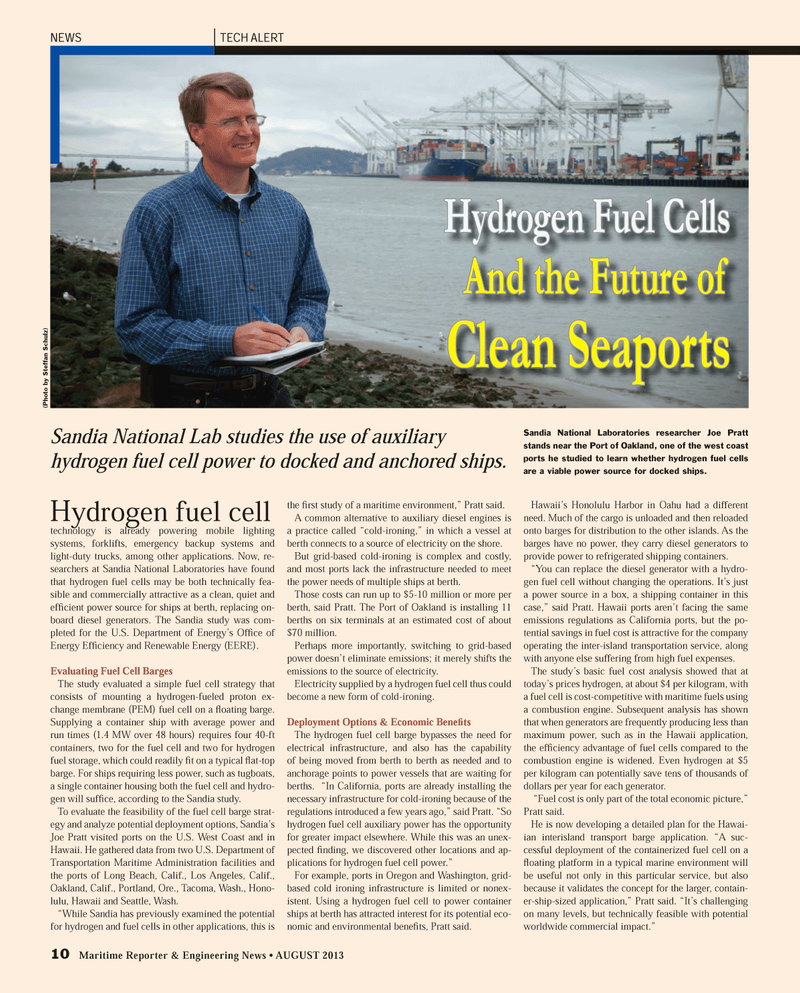
Page 10: of Maritime Reporter Magazine (August 2013)
Shipyard Edition
Read this page in Pdf, Flash or Html5 edition of August 2013 Maritime Reporter Magazine
10 Maritime Reporter & Engineering News ? AUGUST 2013 Hydrogen fuel celltechnology is already powering mobile lighting systems, forklifts, emergency backup systems and light-duty trucks, among other applications. Now, re- searchers at Sandia National Laboratories have found that hydrogen fuel cells may be both technically fea-sible and commercially attractive as a clean, quiet and efÞ cient power source for ships at berth, replacing on- board diesel generators. The Sandia study was com- pleted for the U.S. Department of Energy?s Of Þ ce of Energy Ef Þ ciency and Renewable Energy (EERE). Evaluating Fuel Cell Barges The study evaluated a simple fuel cell strategy that consists of mounting a hydrogen-fueled proton ex-change membrane (PEM) fuel cell on a ß oating barge. Supplying a container ship with average power and run times (1.4 MW over 48 hours) requires four 40-ft containers, two for the fuel cell and two for hydrogen fuel storage, which could readily Þ t on a typical ß at-top barge. For ships requiring less power, such as tugboats, a single container housing both the fuel cell and hydro-gen will sufÞ ce, according to the Sandia study. To evaluate the feasibility of the fuel cell barge strat- egy and analyze potential deployment options, Sandia?s Joe Pratt visited ports on the U.S. West Coast and in Hawaii. He gathered data from two U.S. Department of Transportation Maritime Administration facilities and the ports of Long Beach, Calif., Los Angeles, Calif., Oakland, Calif., Portland, Ore., Tacoma, Wash., Hono- lulu, Hawaii and Seattle, Wash. ?While Sandia has previously examined the potential for hydrogen and fuel cells in other applications, this is the Þ rst study of a maritime environment,? Pratt said. A common alternative to auxiliary diesel engines is a practice called ?cold-ironing,? in which a vessel at berth connects to a source of electricity on the shore. But grid-based cold-ironing is complex and costly, and most ports lack the infrastructure needed to meet the power needs of multiple ships at berth. Those costs can run up to $5-10 million or more per berth, said Pratt. The Port of Oakland is installing 11 berths on six terminals at an estimated cost of about $70 million.Perhaps more importantly, switching to grid-based power doesn?t eliminate emissions; it merely shifts the emissions to the source of electricity. Electricity supplied by a hydrogen fuel cell thus could become a new form of cold-ironing.Deployment Options & Economic BeneÞ tsThe hydrogen fuel cell barge bypasses the need for electrical infrastructure, and also has the capability of being moved from berth to berth as needed and to anchorage points to power vessels that are waiting for berths. ?In California, ports are already installing the necessary infrastructure for cold-ironing because of the regulations introduced a few years ago,? said Pratt. ?So hydrogen fuel cell auxiliary power has the opportunity for greater impact elsewhere. While this was an unex-pected Þ nding, we discovered other locations and ap- plications for hydrogen fuel cell power.? For example, ports in Oregon and Washington, grid- based cold ironing infrastructure is limited or nonex-istent. Using a hydrogen fuel cell to power container ships at berth has attracted interest for its potential eco-nomic and environmental beneÞ ts, Pratt said. Hawaii?s Honolulu Harbor in Oahu had a different need. Much of the cargo is unloaded and then reloaded onto barges for distribution to the other islands. As the barges have no power, they carry diesel generators to provide power to refrigerated shipping containers.?You can replace the diesel generator with a hydro- gen fuel cell without changing the operations. It?s just a power source in a box, a shipping container in this case,? said Pratt. Hawaii ports aren?t facing the same emissions regulations as California ports, but the po-tential savings in fuel cost is attractive for the company operating the inter-island transportation service, along with anyone else suffering from high fuel expenses. The study?s basic fuel cost analysis showed that at today?s prices hydrogen, at about $4 per kilogram, with a fuel cell is cost-competitive with maritime fuels using a combustion engine. Subsequent analysis has shown that when generators are frequently producing less than maximum power, such as in the Hawaii application, the efÞ ciency advantage of fuel cells compared to the combustion engine is widened. Even hydrogen at $5 per kilogram can potentially save tens of thousands of dollars per year for each generator. ?Fuel cost is only part of the total economic picture,? Pratt said.He is now developing a detailed plan for the Hawai-ian interisland transport barge application. ?A suc- cessful deployment of the containerized fuel cell on a ß oating platform in a typical marine environment will be useful not only in this particular service, but also because it validates the concept for the larger, contain- er-ship-sized application,? Pratt said. ?It?s challenging on many levels, but technically feasible with potential worldwide commercial impact.?NEWSTECH ALERT Hydrogen Fuel Cells Hydrogen Fuel Cells And the Future of And the Future of Clean SeapoClean Seaports rts Sandia National Laboratories researcher Joe Pratt stands near the Port of Oakland, one of the west coast ports he studied to learn whether hydrogen fuel cells are a viable power source for docked ships. (Photo by Steffan Schulz) Sandia National Lab studies the use of auxiliary hydrogen fuel cell power to docked and anchored ships. MR #8 (10-17).indd 10MR #8 (10-17).indd 108/1/2013 8:56:26 AM8/1/2013 8:56:26 AM

 9
9

 11
11
